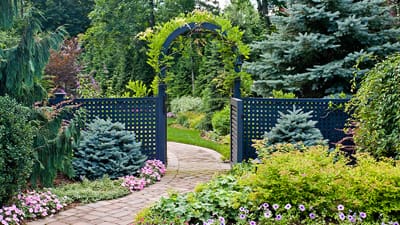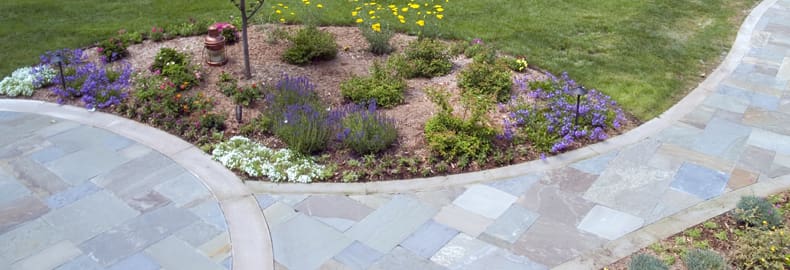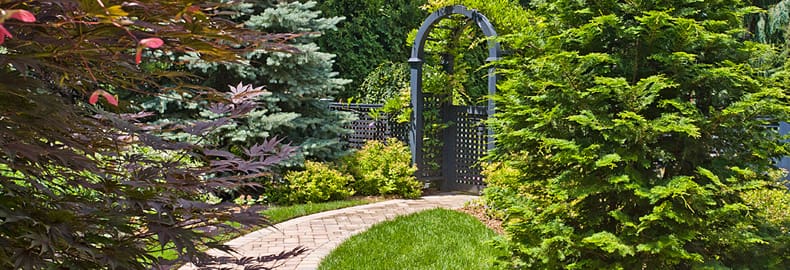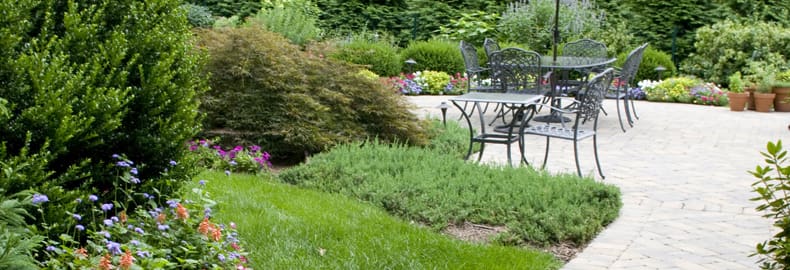 Outdoor walkways can add beauty and interest to your landscape. You can create a dramatic entrance to your front door, a winding pathway through an outdoor garden or a safe path to your swimming pool and spa.
Outdoor walkways can add beauty and interest to your landscape. You can create a dramatic entrance to your front door, a winding pathway through an outdoor garden or a safe path to your swimming pool and spa.
Outdoor walkway installation can enhance the visual appeal of your home and landscape, so good planning and proper installation is essential.
There are endless design possibilities for outdoor walkway installation. They can be designed and built in various sizes, shapes and materials to compliment your home and landscape. Choose from subtle textured materials that will blend naturally into the landscape or colorful materials that will add depth and contrast.
Walkway Design
Outdoor walkways can create long, short, straight or curved pathways through your landscape. They can be designed in plain, simple patterns that blend into the landscape or more intricate patterns that draw attention. They can be installed with contrasting edges and borders or no edges at all. There’s many design possibilities for outdoor walkways. By hiring a professional landscaping contractor, you can create a design for your outdoor walkway installation that compliments your northern NJ home and landscape.
How Big Should My Outdoor Walkway Be?
The size of your outdoor walkway should be proportioned to the size of your yard. Consider an appropriate length and width based on the location of the walkway and where it goes. A walkway that’s too small will look dwarfed by surrounding structures and lack appeal. A walkway that’s too big will overpower the surrounding landscape and look out of place.

Best Walkway Shapes
The shape of your outdoor walkway doesn’t have to follow the shape of your landscape, but it should compliment basic landscape features. If your landscape emphasizes geometric lines, straight outdoor walkway installation will be more appealing. If your landscape emphasizes curved garden areas and borders, curved and winding walkways will be more complimentary.
Outdoor Walkway Materials
There’s a wide variety of materials that are suitable for outdoor walkways. You can use concrete, brick, natural stone, river rock, flagstone and gravel. Many materials come in pavers that can be set in place without grout or mortar. Interlocking pavers are made with edge spacers that interlock for clean, grout-free, outdoor walkway installation that’s fast and easy. Poured materials like concrete or terrazzo require special equipment and skilled installation procedures. When deciding on outdoor walkway materials for your Bergen County home, think about how your walkway will be used.
Concrete
Concrete walkways are popular because they’re strong, durable and reasonably priced. Although basic gray or white concrete is used most often, concrete now comes in over 30 pre-mixed colors and 15 stained finishes. It can be installed with a plain, smooth surface or patterned, decorative surface. Concrete offers a durable, slip-resistant surface that will withstand freezing ground temperatures without cracking or chipping. A sealer should be used to protect against stains and color changes over time.
Poured concrete is excellent for a slab outdoor walkway installation. It provides a smooth even surface with no seams or joints. It can take on any shape when wet and hardens to a strong, durable finish that’s easy to clean with soap and water.
Concrete pavers come in various sizes, shapes and textures. Interlocking pavers come with edge spacers that easily fit together easily without grout or mortar. Pavers are easily replaced if damaged and come with a lifetime warranty.
Stamped concrete mimics more expensive materials like natural stone. By alternating patterns and shapes, you can create a beautiful outdoor walkway that looks like natural stone at half the price.
Brick
Brick outdoor walkways are great for more traditional homes. Bricks can be installed in straight and herringbone patterns that create a classic look with traditional character and timeless appeal. Brick walkway materials are available in full size bricks that require mortar, as well as thinner brick pavers with or without interlocking joints. Pavers come in various sizes and finishes resemble both new and aged bricks. Available colors include classic red and muted shades of rust, brown, tan and green.
Brick is a strong, durable material that provides a slip-resistant surface for outdoor walkway installation. It’s easy to maintain and clean with a garden hose and soapy water. It dries quickly in the sun, but can form a slick mossy film if installed in moist shady areas. Although brick is porous, a sealer isn’t always necessary. Talk to your professional landscape contractor about using a sealer.

Natural Stone
Natural stone is the most popular material for outdoor walkway installation, however it’s also the most expensive. Most homeowners love the beauty of natural stone because it compliments any style of home and landscape. Natural stone pavers, available in granite, marble, limestone, travertine and slate, are easy to install. Their weight holds them firmly in place without the use of mortar. They come in various sizes, shapes, colors and textures with tumbled, honed or polished surfaces. Natural stones are porous and require a sealer once or twice a year for protection from spills and stains.
Rocks
Flagstone and river rock hold up well in their natural state outdoors. They.don’t require a sealer for outdoor walkway installation. If you want added protection, talk to your landscape contractor about adding a sealer to protect against spills and stains.
Aggregate stone and rock creates a casual, natural looking outdoor walkway. It’s inexpensive and can typically be installed in one day. Crushed stone and pea stone have to be packed down firmly with a plastic or cloth barrier underneath. These loose stones can stick to your shoes and get tracked into other areas if not packed down properly.

Outdoor Patio Installation
Poured Walkways
Poured walkways require a skilled professional. Poured materials like concrete and terrazzo require special equipment for mixing, pouring and spreading materials. If you prefer the smooth, sleek look of poured materials, hire a professional landscape contractor for best results.
Paver Walkways
1. Determine the overall square footage of your walkway (square feet = total length x total width). Once you select your materials, you can determine how many pavers are needed per square foot. It’s a good idea to buy 10-15 percent more for cutting pavers to size and having spare materials.
2. Purchase sand and paver base. One cubic yard will cover approximately 108 square feet that’s 3 inches deep. Your landscape contractor or supplier can help you with the conversion.
3. Install pavers
- Excavate the walkway area
- Lay and compact the paver base, topped by a 1-inch layer of concrete sand for proper drainage
- Install metal or plastic edging to give the pavers firm support and hold them in place
- Set the pavers by snugly placing one paver next to another
- Create a pattern that minimizes the number of cut pavers if possible
- Fill the joints with mason’s sand, firmly working it into joints with a vibrating plate compactor
As you can see, outdoor walkway installation will require time, labor and materials. Although installing paver walkways can be a DIY project, we recommend hiring a professional landscape contractor for best long-term results.
